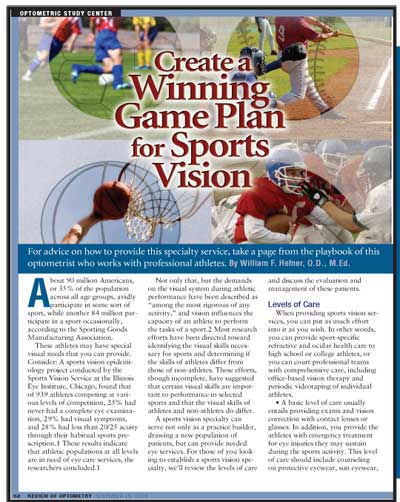
Most doctors understand the need to find that special something that sets their practices apart from the rest. Some have high-end dispensaries that attract patients who have large disposable incomes. Others might focus on low vision, childrens vision, safety vision, computer vision or any other number of specialties or niches that can help them draw an exclusive patient base. In fact, many have done so with great results. But, how to go about it is often baffling and may make you hesitant to pursue your ideas. Following your dream, however, may not be as difficult as you think.
The focus of this months Optometric Study Center is sports vision. Roughly 90 million Americans, or 35% of the population across all age groups, avidly participate in some sort of sport, while another 84 million participate in a sport occasionally, according to the Sporting Goods Manufacturing Association (SGMA).

Create a Winning Game Plan with Sports Vision
Earn 2 CE credits learning about the Pacific Sports Visual Performance Profile and other tools that can help you incorporate a sports vision specialty in your practice.
In Create a Winning Game Plan for Sports Vision, William F. Hefner, O.D., who works with professional athletes, offers advice on how to provide this specialty service. The Topeka, Kan., doctor explains the Pacific Sports Visual Performance Profile (PSVPP), which could help you better understand the various skills necessary in the most common sports, as well as some of the goals of sports vision therapy. Optometrists Bradley Coffey and Alan W. Reichow, who pioneered the PSVPP, designed the profile to standardize the visual performance of Olympic-level and professional athletes. It includes such measures as vergence ranges; central visual recognition; eye-hand, eye-foot reaction speed; and vision and balance to name a few.
Dr. Hefner also provides a detailed listing of the instrumentation that you might use should you decide to break into this exciting optometric specialty. For example, if youre treating a football quarterback, you might want to invest in a tachistiscope, an instrument that measures the speed at which visual information can be interpreted. Or, if any of your patients are target shooters, a Wayne saccadic fixator would be a handy tool.
Without question, if you choose to incorporate sports vision into your practice, it will challenge your clinical skills and alter your exam routine. It will also challenge your business skills, since youll likely be reaching out to patients in ways you hadnt thought of before. But, the optometrists that I have met over the years who practice sports vision have a great time doing so and even enjoy the marketing side.
There are several reasons to give sports vision a try in your practice, including the financial incentive. But, whether you do it for money or just to change things up a bit, sports vision can be a rewarding and exciting specialty.

